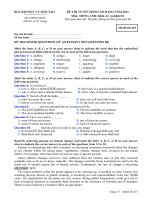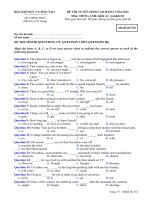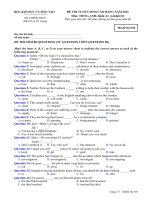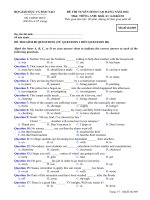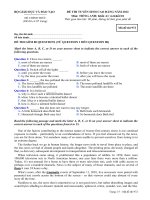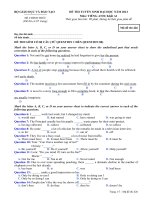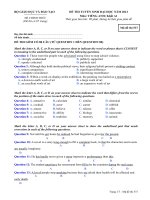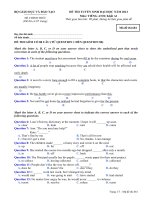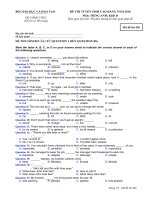ĐỀ THI TUYỂN SINH CAO ĐẲNG NĂM 2012 Môn: TIẾNG ANH; Khối A1 mã 426
Bạn đang xem bản rút gọn của tài liệu. Xem và tải ngay bản đầy đủ của tài liệu tại đây (214 KB, 7 trang )
BỘ GIÁO DỤC VÀ ĐÀO TẠO
ĐỀ CHÍNH THỨC
(Đề thi có 07 trang)
ĐỀ THI TUYỂN SINH ĐẠI HỌC NĂM 2012
Môn: TIẾNG ANH; Khối A1
Thời gian làm bài: 90 phút, không kể thời gian phát đề
Mã đề thi 426
Họ, tên thí sinh:.......................................................................
...
Số báo danh:............................................................................
ĐỀ THI GỒM CÓ 80 CÂU (TỪ QUESTION 1 ĐẾN QUESTION 80)
Mark the letter A, B, C, or D on your answer sheet to show the underlined part that needs
correction in each of the following questions.
Question 1: Not until he
got home he realised he had forgotten to give her the present.
A B C D
Question 2: He has hardly never given a more impressive performance than this.
A B C D
Question 3:
A lot of people stop smoking because they are afraid their health will be affected
A B C
and early death.
D
Question 4: The student
must have her assessment form fill in by the examiner during the oral exam.
A B C D
Question 5: A novel is a story
long enough to fill a complete book, in that the characters and events
A B C
are usually imaginary.
D
Mark the letter A, B, C, or D on your answer sheet to indicate the correct answer to each of the
following questions.
Question 6: I ______ work last week, but I changed my mind.
A. would start B. had started C. have started D. was going to start
Question 7: The Principal usually has his pupils ______ waste paper for their mini-project.
A. having collected B. collect C. collected D. to collect
Question 8: He came ______ a lot of criticism for the remarks he made in a television interview.
A. in for B. over C. out of D. off
Question 9: They live on a busy road. ______ a lot of noise from traffic.
A. There must have B. It must have been C. There must be D. It must be
Question 10: Tom: “Can I have another cup of tea?”
Christy: “______.”
A. Be yourself B. Do it yourself C. Allow yourself D. Help yourself
Question 11: Lora: “Do you mind if I turn on the fan?”
Maria: “______.”
A. Not for me B. Not at all C. Never mind D. Not enough
Question 12: Due to ever more spreading poaching, there ______ a dramatic decline in the number of
elephants over the last decade.
A. has been B. is C. was D. had been
Question 13: ______ make a good impression on her.
A. Only by doing so can I B. Only so doing can I
C. Only by so doing I can D. Only by doing so I can
Question 14: People don’t like the way he shows off, ______?
A. don’t they B. do they C. does he D. doesn’t he
Trang 1/7 - Mã đề thi 426
Question 15: The use of vitamin ______ and herbs has become increasingly popular among
Americans.
A. materials B. ingredients C. supplements D. components
Question 16: No matter how angry he was, he would never ______ to violence.
A. refuse B. resort C. resist D. resolve
Question 17: ______ that Columbus discovered America.
A. In 1492 B. There was in 1492 C. That was in 1492 D. It was in 1492
Question 18: Anna is holding her shopping bag with one hand and turning the door handle with ______.
A. other B. another C. the other D. others
Question 19: I can’t find my dictionary at the moment. I hope it will ______ up soon.
A. look B. clear C. turn D. come
Question 20: The language centre offers courses of various levels, such as elementary,
intermediate and ______.
A. advance B. advancement C. advanced D. advancing
Question 21: She started the course two months ago but dropped ______ after only a month.
A. back B. out C. off D. in
Question 22: Nowadays, with the help of the computer, teachers have developed a ______ approach
to teaching.
A. multilingual B. multilateral C. multiple-choice D. multimedia
Question 23: He died ______ lung cancer last month, leaving his wife in great shock.
A. for B. by C.
of D. in
Question 24: He is a very intelligent boy; ______, he sometimes gets bad marks.
A. so B. thus C. otherwise D. however
Question 25: I ______ with my aunt when I am on holiday in Ho Chi Minh City next month.
A. will have been staying B. will have stayed
C. stay D. will be staying
Question 26: Although we have a large number of students, each one receives ______ attention.
A. alone B. only C. separate D. individual
Question 27: The children made ______ a funny story and wrote it on the card.
A. up B. off C. for D. out
Question 28: Geometry is a branch of mathematics ______ the properties of lines, curves, shapes,
and surfaces.
A. that concerning with B. that concerned with
C. that it is concerned with D. concerned with
Question 29: She passed the National High School Graduation Exam with ______ colours.
A. bright B. flying C. red D. true
Question 30: Ann: “Do you need any help?”
Kate: “______.”
A. That’s fine by me B. No, thanks. I can manage
C. I haven’t got a clue D. That’s all for now
Mark the letter A, B, C, or D on your answer sheet to indicate the word or phrase that is CLOSEST
in meaning to the underlined part in each of the following questions.
Question 31: Although they hold similar political views, their religious beliefs present a
striking contrast.
A. minor comparison B. significant difference
C. complete coincidence D. interesting resemblance
Trang 2/7 - Mã đề thi 426
Question 32: Within a week on display at the exhibition, the painting was hailed as a masterpiece.
A. a large work of art B. an expensive work of art
C. an excellent work of art D. a down-to-earth work of art
Question 33: These were the people who advocated using force to stop school violence.
A. publicly said B. publicly supported
C. strongly condemned D. openly criticised
Read the following passage on transport, and mark the letter A, B, C, or D on your answer sheet to
indicate the correct answer to each of the questions from 34 to 43.
Most journeys in Britain and the US are made by road. Some of these are made on public transport
but most are by private car.
In Britain many people rely on their cars for daily local activities, e.g. getting to work, doing the
shopping, and visiting friends. People living in urban areas may use buses, trains or, in London, the
Underground, to get to city centres, mainly because traffic is often heavy and it is difficult to find
anywhere to park a car. Some places in the country may have a bus only two or three times a week so
people living there have no choice but to rely on their cars.
In the US large cities have good public transportation systems. The El railroad in Chicago and the
underground systems of New York, Boston, San Francisco and Washington, DC are heavily used.
Elsewhere, most Americans prefer to use their cars. Families often have two cars and, outside major
cities, have to drive fairly long distances to schools, offices, shops, banks, etc. Many college and even
high-school students have their own cars.
Long-distance travel in Britain is also mainly by road, though railways link most towns and cities.
Most places are linked by motorways or other fast roads and many people prefer to drive at their
own convenience rather than use a train, even though they may get stuck in a traffic jam. Long-
distance coach/bus services are usually a cheaper alternative to trains, but they take longer and may
be less comfortable. Some long-distance travel, especially that undertaken for business reasons, may
be by air. There are regular flights between regional airports, as well as to and from London. A lot of
freight is also distributed by road, though heavier items and raw materials often go by rail.
In the US much long-distance travel is by air. America has two main long-distance bus companies,
Greyhound and Trailways. Amtrak, the national network, provides rail services for passengers.
Private railway companies such as Union Pacific now carry only freight, though in fact over 70% of
freight goes by road.
The main problems associated with road transport in both Britain and the US are traffic congestion
and pollution. It is predicted that the number of cars on British roads will increase by a third within a
few years, making both these problems worse. The British government would like more people to use
public transport, but so far they have had little success in persuading people to give up their cars or to
share rides with neighbours. Most people say that public transport is simply not good enough.
Americans too have resisted government requests to share cars because it is less convenient and
restricts their freedom. Petrol/gasoline is relatively cheap in the US and outside the major cities
public transport is bad, so they see no reason to use their cars less.
(Extracted from Oxford Guide to British and American Culture, Oxford University Press, 2000)
Question 34: In Britain and the US most people travel by ______.
A. road B. sea C. rail D. air
Question 35: According to the passage, people in London may prefer the Underground to their own
cars due to ______.
A. heavy traffic B. cheap tickets C. long distances D. air pollution
Question 36: It is mentioned in paragraph 3 that the public transportation systems in the US are good
in ______.
A. large cities B. large states C. some states D. all cities
Trang 3/7 - Mã đề thi 426
Question 37: Which of the following is NOT true according to the passage?
A. Few college students in the US have their own cars.
B. The underground systems are popular in some major US cities.
C. Most Americans prefer to drive their cars outside large cities.
D. Families in the US often have more than one car.
Question 38: The phrase “at their own convenience” in paragraph 4 is closest in meaning to ______.
A. at an early time and nearby place B. at the fastest time and nearest place
C. at the latest time and nearest place D. at an appropriate time and place
Question 39: Which of the following is true about transport in Britain?
A. Trains are usually cheaper than long-distance coach services.
B. There are no regular flights between regional airports.
C. Heavier items and raw materials are often transported by train.
D. Long-distance travel in Britain is only by road.
Question 40: According to the information in paragraph 5, long-distance travellers in the US can
choose from ______ mode(s) of transport.
A. four B. three C. two D. one
Question 41: It is stated in the passage that the major problems of road transport in Britain and the
US are ______.
A. speeding and bad roads B. drink-driving and traffic jams
C. traffic jams and pollution D. accidents and pollution
Question 42: According to the passage, people in Britain refuse public transport because ______.
A. they think it is not good enough B. they see no reason to use their cars less
C. petrol is relatively cheap in Britain D. they like to share rides with neighbours
Question 43: The word “they” in the last sentence of the passage can best be replaced by ______.
A. major cities B. Americans C. the government D. neighbours
Read the following passage on architecture by Lawrence B. Anderson, and mark the letter A, B, C,
or D on your answer sheet to indicate the correct answer to each of the questions from 44 to 53.
Architecture is the practice of building design and its resulting products; customary usage refers only
to those designs and structures that are culturally significant. Architecture is to building as literature
is to the printed word. Vitruvius, a 1
st
-century BC Roman, wrote encyclopedically about architecture,
and the English poet Sir Henry Wotton was quoting him in his charmingly phrased dictum: “Well
building hath three conditions: Commoditie, Firmenes, and Delight.” More prosaically, one would
say today that architecture must satisfy its intended uses, must be technically sound, and must convey
aesthetic meaning. But the best buildings are often so well constructed that they outlast their original
use. They then survive not only as beautiful objects, but as documents of the history of cultures,
achievements in architecture that testify to the nature of the society that produced them. These
achievements are never wholly the work of individuals. Architecture is a social art.
Architectural form is inevitably influenced by the technologies applied, but building technology is
conservative and knowledge about it is cumulative. Precast concrete, for instance, has not rendered
brick obsolete. Although design and construction have become highly sophisticated and are often
computer directed, this complex apparatus rests on preindustrial traditions inherited from millennia
during which most structures were lived in by the people who erected them. The technical demands
on building remain the elemental ones – to exclude enemies, to circumvent gravity, and to avoid
discomforts caused by an excess of heat or cold or by the intrusion of rain, wind, or vermin. This is
no trivial assignment even with the best modern technology.
The availability of suitable materials fostered the crafts to exploit them and influenced the shapes
of buildings. Large areas of the world were once forested, and their inhabitants developed carpentry.
Although it has become relatively scarce, timber remains an important building material.
Trang 4/7 - Mã đề thi 426
Many kinds of stone lend themselves to building. Stone and marble were chosen for important
monuments because they are incombustible and can be expected to endure. Stone is also a sculptural
material; stone architecture was often integral with stone sculpture. The use of stone has declined,
however, because a number of other materials are more amenable to industrial use and assembly.
Some regions lack both timber and stone; their peoples used the earth itself, tamping certain
mixtures into walls or forming them into bricks to be dried in the sun. Later they baked these
substances in kilns, producing a range of bricks and tiles with greater durability.
(Extracted from Microsoft
®
Encarta
®
2009 Encyclopedia
– DVD Version)
Question 44: According to the passage, the term “architecture” is normally used to refer to the
designs and structures that have ______.
A. religious significance B. social importance
C. technical importance D. cultural significance
Question 45: Which of the following is NOT considered an essential characteristic of architecture
according to the passage?
A. Strength B. Utility C. Economy D. Beauty
Question 46: When well-constructed buildings exist longer than their original use, they serve as ______.
A. monuments to ancient time heroes B. museums and exhibition galleries
C. witnesses to major ancient wars D. witnesses to their historical times
Question 47: The author uses the phrase “social art” in the first paragraph to emphasise that architecture
is an ______.
A. art that belongs to a society B. art that is very much socialised
C. achievement of many people D. achievement of many sociologists
Question 48: According to the passage, knowledge about building technology ______.
A. is always influenced by a wide range of technological applications
B. has experienced complete changes for generations
C. is based on modern technologies rather than traditions
D. includes the experience gained from generation to generation
Question 49: The word “obsolete” in paragraph 2 mostly means ______.
A. out of date B. out of place C. out of order D. out of hand
Question 50: Which of the following factors must be taken into account in both ancient and modern
architecture according to the information in paragraph 2?
A. Basic needs and the availability of materials B. Fundamental technical demands on building
C. Sophisticated building technologies D. Basic safety rules in the building industry
Question 51: According to the passage, stone and marble were used for buildings of historical
importance because they ______.
A. make structures look more attractive B. are inflammable and endurable
C.
give warmth and comfort to their owners D. are non-flammable and last long
Question 52: According to the passage, today stone has been used less as a building material
because ______.
A. there have been other more suitable materials for industrial use
B. stone architecture is essential to the number of stone sculptures
C. it has less influence on the shapes of buildings and sculptures
D. it has become relatively scarce and more difficult to exploit
Question 53: The word “their” in the last paragraph refers to ______.
A. walls and bricks B. mixtures C. timber and stone D. regions
Mark the letter A, B, C, or D on your answer sheet to indicate the word or phrase that is OPPOSITE
in meaning to the underlined part in each of the following questions.
Question 54: The consequences of the typhoon were
disastrous due to the lack of precautionary
measures.
A. physical B. severe C. beneficial D. damaging
Trang 5/7 - Mã đề thi 426

